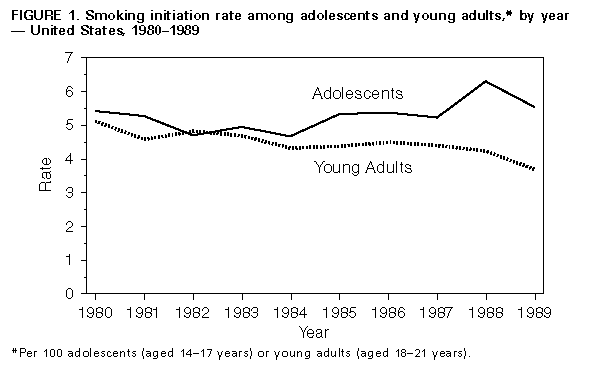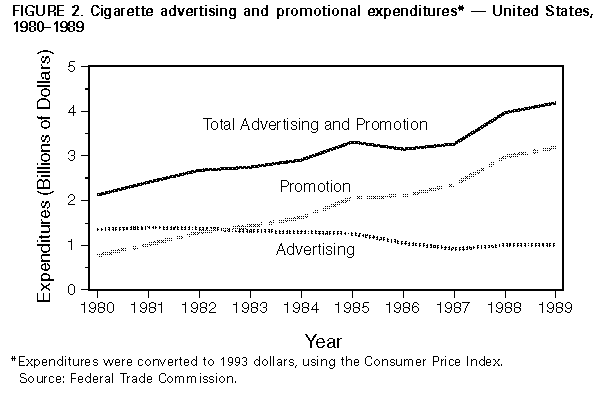 |
|
|
|
|
|
|
|
|
|
|
|
|
|
|
|
|
||||
| ||||||||||
|
|
|
|
Trends in Smoking Initiation Among Adolescents and Young Adults -- United States, 1980-1989The evaluation of efforts to prevent tobacco use among adolescents requires accurate surveillance of both smoking prevalence and smoking initiation rates. Although several surveillance systems provide timely data about adolescent smoking prevalence (1), data characterizing rates of smoking initiation among adolescents have been limited. To improve characterization of trends in smoking initiation among young persons, data from the Tobacco Use Supplement of the 1992 and 1993 Current Population Surveys (CPS) (2) were used to estimate smoking initiation rates for persons who were adolescents (aged 14-17 years) or young adults (aged 18-21 years) during 1980-1989. This report summarizes the results of that analysis. The CPS are monthly surveys of the U.S. civilian, noninstitutionalized population aged greater than or equal to 15 years (2). Approximately 56,000 households are surveyed each month; one household respondent provides information about all household members aged greater than or equal to 15 years. Questions about tobacco use were added to the September 1992, January 1993, and May 1993 monthly surveys. The response rates for the three surveys were 84.7%, 84.9%, and 82.0%, respectively (N=293,543 household members). To minimize biases that could result from discrepancies between self reports and proxy reports of smoking behavior (3), this analysis used data from self-respondents only (82% of total sample). Ever smokers were defined as respondents who answered "yes" to the question, "Have you smoked at least 100 cigarettes in your entire life?" Ever smokers were asked, "How old were you when you started smoking cigarettes fairly regularly?" To restrict the analysis to persons who were adolescents or young adults for some period during 1980-1989, only respondents aged 17-34 years at interview were included. The final sample consisted of 71,321 persons, of whom 27,768 (38.9%) were ever smokers. Using the age of respondents at the time of the interview and the age they reported starting smoking, the age of respondents and their smoking status were calculated for each year during the 1980s. The denominator for the initiation rate for a given year was the number of respondents at risk for initiating smoking during that year (persons already smoking were eliminated from the denominator for that year). The numerator was the number of respondents who reported initiating smoking during that year. Data were weighted by age, sex, and race/ethnicity to provide national estimates. Among adolescents, the smoking initiation rate decreased slightly from 1980 (5.4%) through 1984 (4.7%) and then increased through 1989 (5.5%); the largest annual increase occurred in 1988 Figure_1. In comparison, among young adults, initiation rates decreased throughout the 1980s Figure_1. For both age groups, initiation rates and trends were similar for males and females. Reported by: KM Cummings, PhD, D Shah, MS, Roswell Park Cancer Institute, Buffalo, New York. DR Shopland, National Cancer Institute, National Institutes of Health. Office on Smoking and Health, National Center for Chronic Disease Prevention and Health Promotion, CDC. Editorial NoteEditorial Note: The findings in this report indicate an increase in the rate of initiation of cigarette smoking among adolescents from 1985 through 1989, a period during which the rate among young adults declined and overall prevalence of smoking among adults decreased steadily (4). One important consequence of the increased rate of initiation among adolescents will be the increased future burden of tobacco- related disease. In particular, because of the increase in initiation since 1984, an additional 600,000 adolescents began to smoke during 1985-1989. * Of those adolescents who continue to smoke regularly, approximately 50% will die from smoking-attributable disease (5). Potential reasons for an increase in smoking initiation rates among adolescents include a decreased real price of cigarettes, increased levels of disposable income, increased acceptability of smoking, and intensified cigarette marketing (1). However, because the real price of cigarettes increased steadily during 1985-1989 and the real average weekly income among high school seniors remained stable during this period, cigarettes were less affordable to young persons (1,6) Table_1. In addition, the acceptability of smoking among high school seniors did not increase: during this period there were increases in the percentages of high school seniors who believed cigarettes are harmful, smoking is a "dirty habit," and becoming a smoker reflects poor judgment, and who reported they "mind being around people who are smoking" and would prefer to date nonsmokers (1). The increase in rates of smoking initiation among adolescents during 1985-1989 may reflect increased real expenditures for cigarette advertising and promotion. The increase in rates occurred during a period when real expenditures for total cigarette advertising and promotion ** doubled, and expenditures for cigarette promotion more than quadrupled (7) Figure_2: from 1980 to 1989, total annual advertising and promotional expenditures (in 1993 dollars) increased from $2.1 billion to $4.2 billion, while promotional expenditures alone increased from $771 million (37% of total expenditures) to $3.2 billion (76%) Figure_2. Promotional efforts have been highly effective among adolescents. For example, among persons aged 12-17 years in 1992, approximately 50% of smokers and 25% of nonsmokers reported having received promotional items from tobacco companies (1). An association between overall cigarette marketing expenditures and initiation rates for smoking among adolescents is plausible for at least four reasons. First, brand loyalty is usually established with the first cigarette smoked (8); therefore, cigarette companies have an economic incentive to encourage first-time smokers to smoke their brands. Second, adolescents are exposed to cigarette advertising and promotions that employ themes and images that appeal to young persons (1). Third, advertising directly influences brand awareness and attitudes toward smoking among adolescents (1). Specifically, adolescents smoke the most heavily advertised brands, and changes in brand preferences among young persons are associated with changes in brand-specific advertising expenditures (9). For example, the Joe Camel campaign introduced nationally in 1988 was associated with an increase in the market share of that specific brand among adolescents (1,9). Finally, consumer research suggests that younger persons (i.e., aged 14-17 years) aspire to be young adults (10); therefore, advertising and promotional efforts targeted toward young adults may have greater appeal to adolescents because of their age aspirations. Although current estimates of smoking initiation rates among adolescents are not available, from 1991 through 1993, the national prevalence of smoking increased among eighth- and 10th-grade students (6). To reverse the trend of increasing smoking initiation rates among adolescents and to achieve the national health objective for the year 2000 of reducing the initiation of cigarette smoking by youth (no more than 15% should become regular smokers by age 20) (objective 3.5) (4), prevention efforts that focus on young persons should be intensified. Such efforts could include making cigarettes less affordable by either increasing their real price (1) or by limiting sales to cartons rather than individual packs, enforcing laws prohibiting the sale and distribution of cigarettes to young persons (4), conducting mass media campaigns to discourage tobacco use (1), and eliminating or severely restricting all forms of tobacco product advertising and promotion to which young persons are likely to be exposed (4). References
* Based on the assumption that the initiation rate during 1985-1989 remained stable at the 1984 rate, and by multiplying the Bureau of the Census population estimates for persons aged 14-17 years for each year from 1985 through 1989 by the difference between the adolescent smoking initiation rate in 1984 and the rate for each year. ** Based on data from the Federal Trade Commission (7), advertising expenditures include costs to advertise outdoors (e.g., billboards), in newspapers or magazines, and on transportation (e.g., buses); promotional expenditures include costs of promotional allowances, distribution of samples or specialty items (e.g., key chains, lighters, T-shirts, caps, and calendars), public entertainment, direct mail, coupons, retail value-added promotions (e.g., specialty items distributed at the point of sale), and point-of-sale promotions (e.g., store displays). Figure_1  Return to top. Table_1 Note: To print large tables and graphs users may have to change their printer settings to landscape and use a small font size.
TABLE 1. Real * cigarette price per pack, real weekly income of high school seniors, and
real price per pack as a percentage of real weekly income among high school seniors
-- United States, 1980-1989
==========================================================================================
Real price of cigarette
Real average cigarette Real average weekly pack as percentage of
Year price per pack (cents) + income (dollars) & real weekly income
------------------------------------------------------------------------------------------
1980 72.8 NA @ NA
1981 69.3 NA NA
1982 72.2 52.83 1.4
1983 82.2 51.26 1.6
1984 91.1 52.00 1.7
1985 90.9 51.84 1.7
1986 95.3 53.63 1.8
1987 96.8 55.15 1.8
1988 103.3 53.53 1.9
1989 102.8 53.13 1.9
------------------------------------------------------------------------------------------
* Real prices and incomes were obtained by dividing the actual prices and incomes by
the National Consumer Price Index, using the average of 1982-1984 as the reference.
+ Source: The Tobacco Institute.
& Sourec: CDC.
@ Not available.
==========================================================================================
Return to top. Figure_2  Return to top. Disclaimer All MMWR HTML versions of articles are electronic conversions from ASCII text into HTML. This conversion may have resulted in character translation or format errors in the HTML version. Users should not rely on this HTML document, but are referred to the electronic PDF version and/or the original MMWR paper copy for the official text, figures, and tables. An original paper copy of this issue can be obtained from the Superintendent of Documents, U.S. Government Printing Office (GPO), Washington, DC 20402-9371; telephone: (202) 512-1800. Contact GPO for current prices. **Questions or messages regarding errors in formatting should be addressed to mmwrq@cdc.gov.Page converted: 09/19/98 |
|||||||||
This page last reviewed 5/2/01
|